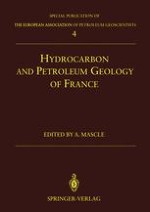1994 | OriginalPaper | Buchkapitel
Multiphase Extensional Structures, Fault Reactivation, and Petroleum Plays in the Alpine Foreland Basin of Southeastern France
verfasst von : F. Roure, J. P. Brun, B. Colletta, R. Vially
Erschienen in: Hydrocarbon and Petroleum Geology of France
Verlag: Springer Berlin Heidelberg
Enthalten in: Professional Book Archive
Aktivieren Sie unsere intelligente Suche, um passende Fachinhalte oder Patente zu finden.
Wählen Sie Textabschnitte aus um mit Künstlicher Intelligenz passenden Patente zu finden. powered by
Markieren Sie Textabschnitte, um KI-gestützt weitere passende Inhalte zu finden. powered by
Jurassic and Oligocene extensional structures are still well preserved in the compressional basin of southeastern France. Due to the occurrence of numerous potential decollement levels (i. e., the Carboniferous coal measures, the Triassic evaporites, the Jurassic blackshales, or the Neocomian marls), these structures frequently independently involve the crystalline basement and the sedimentary cover, thus illustrating various structural styles that are clearly imaged in seismic profiles.Local Paleogene and Neogene tectonic inversions have modified the early extensional structures, especially at the boundary between Mesozoic basinal and platform domains. A large wedging of the shallow Cretaceous platform sequences thus occurred over a deep indenter made of Mesozoic basinal sequences, and is best imaged along La Lance-Valence transect in the Rhône Valley. Alternatively, wedging of the Mesozoic cover relates to the tectonic inversion of a buried Paleozoic basin along the Pic-St Loup profile in Languedoc. A similar backthrusting occurs in the thin-skinned cover units of the Jura Mtns near Oyonnax, and probably also relates to the recent inversion of a deeper Paleozoic basin. The relative timing of surface backthrusting and deeper basin inversion was analyzed by means of various techniques. Intermediate geometries of these complex triangle structures are thus discussed by using cross-section balancing techniques, and are then compared with analogue models.In Neogene times, a collapse of the Pyrenean edifice occurred synchronously with the opening of the Gulf of Lions. During the building up of this new Mediterranean continental margin, the late Cretaceous to Paleogene sole-thrust of the tectonic pile was reactivated as an extensional detachment. Distensive piggy-back basins developed locally above the flats of this multiphase decollement surface north of La Clape Mtn. The development and intermediate geometries of these post-compressional collapse basins are also discussed with reference to analogue models.Besides its complex architecture and partial inversion, which make this area a frontier zone for exploration, the basin of southeastern France still preserves locally unaltered Jurassic extensional structures, either (1) near the Ardèche margin, away from the areas reactivated during the Oligocene extension or Neogene inversions; (2) in the autochthon, along the Drôme River beneath the Vercors allochthon or in the Gabian area beneath the St Chi nian allochthon; (3) inside reactivated blocks, in between the sole and roof thrusts of cover duplexes. Early generated oils have hopefully been preserved from secondary migration or cracking in these relict Jurassic structures.Alternatively, during the Alpine thrust emplacement (Vercors), the overburial of the external parts of the basin led to a new episode of maturation. Similarly, the thick sedimentary infill of Ohgocene (Bresse, Valence, Alès) or Neogene (Camargue, southern Languedoc) basins and the contemporaneous and local increase of the heat flow may have contributed to the generation of new oils, either from Tertiary source rocks or from deeper Mesozoic or Paleozoic horizons. In these latter cases, post-Jurassic traps should also be prospected.
